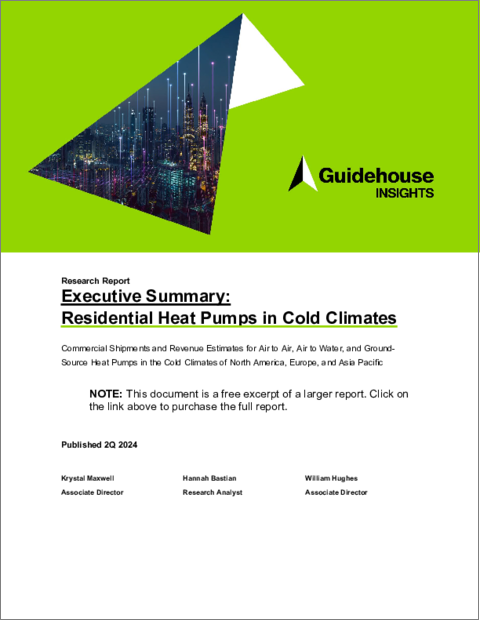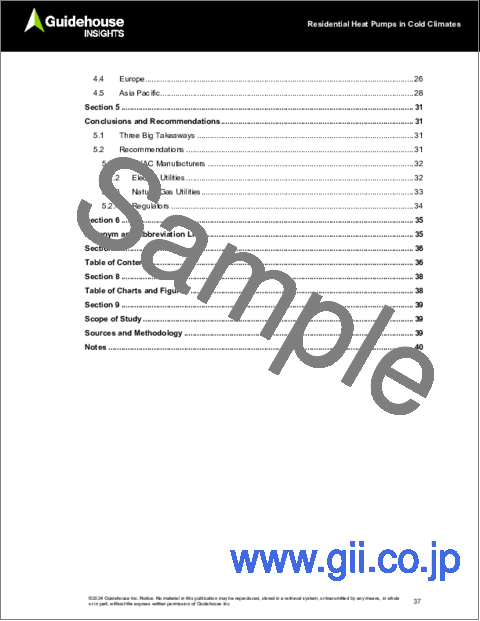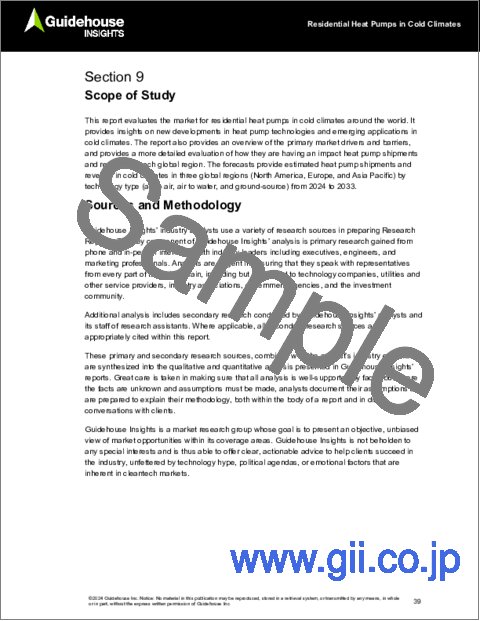|
|
市場調査レポート
商品コード
1501967
寒冷地向け住宅用ヒートポンプResidential Heat Pumps in Cold Climates: Shipments and Revenue Estimates for Air to Air, Air to Water, and Ground-Source Heat Pumps in the Cold Climates of North America, Europe, and Asia Pacific |
||||||
|
|||||||
| 寒冷地向け住宅用ヒートポンプ |
|
出版日: 2024年06月26日
発行: Guidehouse Research
ページ情報: 英文 41 Pages; 26 Tables, Charts & Figures
納期: 即納可能
|
全表示
- 概要
- 図表
- 目次
寒冷地向け住宅用ヒートポンプ市場は、今後10年間で大きく成長すると予想されます。主にインバーター駆動コンプレッサーや冷媒における技術進歩により、ヒートポンプは寒冷地でも十分な性能を発揮できるようになりました。こうした進歩にもかかわらず、寒冷地向けヒートポンプ技術の採用は、一部の欧州諸国と日本を除けば、比較的低い水準にとどまっています。しかし、各国政府や利害関係者がより広範な気候変動対策の一環として建築物の脱炭素化目標を追求する中、暖房の脱炭素化の手段として、寒冷地向けヒートポンプの利用を求める声が多くなっています。このような取り組みが、今後10年間における寒冷地向けヒートポンプ導入の主な促進要因となりそうです。
現在市場に出回っているヒートポンプ技術のうち、寒冷地の住宅に適しているのは、空気対空気 (Air to Air) ヒートポンプ、空気対水 (Air to Water) ヒートポンプ、地中熱ヒートポンプの3つです。直近の出荷量データによると、北米・欧州・アジア太平洋の寒冷地では、上記3種類の技術の採用が拡大しています。世界市場ではこれまで空気対空気ヒートポンプが支配的な技術でしたが、特に欧州では空気対水ヒートポンプが一般的になりつつあります。寒冷地向け住宅暖房用ヒートポンプ技術の新たな用途として、ハイブリッド型ヒートポンプシステム、地域暖房、共有地中熱アレイ (共有地中熱ヒートポンプとしても知られる) など、成長の可能性を示すものもいくつか出てきています。
当レポートでは、世界の寒冷地向け住宅用ヒートポンプの市場について分析し、市場の基本動向や寒冷地固有の促進・抑制要因、寒冷地向けヒートポンプ技術の出荷台数・収益額の動向見通し (2024~2032年)、地域別 (北米、欧州、アジア太平洋)・技術の種類別 (空気対空気、空気対水、地中熱源ヒートポンプ) の詳細動向などを調査しております。さらに、地域ごとの出荷台数・収益額の成長動向や、地域ごとの成長率の差異とその原因なども調査しております。
目次
第1章 エグゼクティブサマリー
第2章 市場の問題
- 寒冷地向け技術の動向
- 可変速インバータ
- 寒冷地向けの一般的なヒートポンプ技術
- 新たな活用領域
- ハイブリッド型ヒートポンプシステム
- ヒートポンプと地域暖房
- 共用地中熱ヒートポンプシステム
- 市場促進要因
- 政府の政策と市場変革の取り組み
- 燃料費と燃料不足
- 障壁
- 天然ガス価格の低下
- 電気サービスの更新
- 不十分な建物の外装が不十分
- 従業員・顧客の教育
- 緊急交換
第3章 業界のバリューチェーン
- 住宅用HVACのバリューチェーン
- 競合情勢
- 製造能力の拡大
第4章 市場予測
- 調査手法
- 世界市場
- 北米
- 欧州
- アジア太平洋
第5章 結論・提言
- 3つの大きなポイント
- 推奨事項
- HVACメーカー
- 電力企業
- 天然ガス・ユーティリティ
- 規制当局
第6章 頭字語・略語一覧
第7章 目次
第8章 図表
第9章 調査範囲、情報源・調査手法、注釈
List of Tables
- Heat Pump Shipments in Cold Climates by Region, World Markets: 2024-2033
- Heat Pump Shipments in Cold Climates by Technology Type, World Markets: 2024-2033
- Heat Pump Revenue in Cold Climates by Region, World Markets: 2024-2033
- Heat Pump Revenue in Cold Climates by Technology Type, World Markets: 2024-2033
- Heat Pump Shipments in Cold Climates by Technology Type, North America: 2024-2033
- Heat Pump Revenue in Cold Climates by Technology Type, North America: 2024-2033
- Heat Pump Shipments in Cold Climates by Technology Type, Europe: 2024-2033
- Heat Pump Revenue in Cold Climates by Technology Type, Europe: 2024-2033
- Heat Pump Shipments in Cold Climates by Technology Type, Asia Pacific: 2024-2033
- Heat Pump Revenue in Cold Climates by Technology Type, Asia Pacific: 2024-2033
New Commercially Available Products Designed for Cold-Climate Markets
New Manufacturing Sites for Producing Cold-Climate Heat Pumps
List of Figures
- Heat Pump Shipments in Cold Climates by Region, World Markets: 2024-2033
- Heat Pump Shipments in Cold Climates by Technology Type, World Markets: 2024-2033
- Heat Pump Revenue in Cold Climates by Region, World Markets: 2024-2033
- Heat Pump Revenue in Cold Climates by Technology Type, World Markets: 2024-2033
- Heat Pump Shipments in Cold Climates by Technology Type, North America: 2024-2033
- Heat Pump Revenue in Cold Climates by Technology Type, North America: 2024-2033
- Heat Pump Shipments in Cold Climates by Technology Type, Europe: 2024-2033
- Heat Pump Revenues in Cold Climates by Technology Type, Europe: 2024-2033
- Heat Pump Shipments in Cold Climates by Technology Type, Asia Pacific: 2024-2033
- Heat Pump Revenue in Cold Climates by Technology Type, Asia Pacific: 2024-2033
Air Source Heat Pump Technologies and Configurations
Ground-Source Heat Pump Configurations
Shared Ground-Source Heat Pumps Compared to Individual Systems
Pictorial Representation of the Residential HVAC Value Chain
The market for residential heat pumps in cold climates is expected to grow considerably over the next decade. Technological advances, primarily in inverter-driven compressors and refrigerants, have enabled heat pumps to perform well in cold climates. Despite these advances, the adoption of heat pump technologies in cold climates has remained relatively low, apart from a few countries in Europe and Japan. However, as governments and stakeholder organizations pursue building decarbonization goals as part of broader climate initiatives, many are calling for the use of heat pumps in cold climates as a way to decarbonize heating. These efforts are likely to be the primary driver for heat pump adoption in cold climates over the next 10 years.
Three predominant heat pump technologies are on the market today and suitable for homes in cold climates: air to air heat pumps, air to water heat pumps, and ground-source heat pumps. Recent historical shipment data shows growing adoption of each of these technologies in cold climates in North America, Europe, and Asia Pacific. While air to air heat pumps have historically been the dominant technology in world markets, air to water heat pumps are becoming more common, particularly in Europe. A few emerging applications of heat pump technology for residential heating in cold climates are also showing growth potential, including hybrid heat pump systems, district heating, and shared geothermal arrays (also known as shared ground-source heat pumps).
This Guidehouse Insights report explores these market trends in detail along with market drivers and barriers specific to cold climates. The forecasts evaluate the estimated shipments and revenue of heat pump technologies in cold climates from 2024 to 2033. They are segmented by region (North America, Europe, and Asia Pacific) and technology type (air to air, air to water, and ground-source heat pumps). The forecasts also provide detailed insights into the unique trends in shipments and revenue growth for each region, including explanations of potential reasons why different technologies appear to be growing faster than others in each region
Table of Contents
1. Executive Summary
2. Market Issues
- 2.1 Technology Trends for Cold Climates
- 2.1.1 Variable Speed Inverters
- 2.2 Common Heat Pump Technologies in Cold Climates
- 2.3 Emerging Applications
- 2.3.1 Hybrid Heat Pump Systems
- 2.3.2 Heat Pumps and District Heating
- 2.3.3 Shared Ground-Source Heat Pump System
- 2.4 Market Drivers
- 2.4.1 Government Policies and Market Transformation Efforts
- 2.4.2 Fuel Costs and Scarcity
- 2.5 Barriers
- 2.5.1 Low Natural Gas Prices
- 2.5.2 Electric Service Upgrades
- 2.5.3 Insufficient Building Envelopes
- 2.5.4 Workforce and Customer Education
- 2.5.5 Emergency Replacements
3. Industry Value Chain
- 3.1 Residential HVAC Value Chain
- 3.2 Competitive Landscape
- 3.3 Growing Manufacturing Capacity
4. Market Forecasts
- 4.1 Methodology
- 4.2 World Markets
- 4.3 North America
- 4.4 Europe
- 4.5 Asia Pacific
5. Conclusions and Recommendations
- 5.1 Three Big Takeaways
- 5.2 Recommendations
- 5.2.1 HVAC Manufacturers
- 5.2.2 Electric Utilities
- 5.2.3 Natural Gas Utilities
- 5.2.4 Regulators





